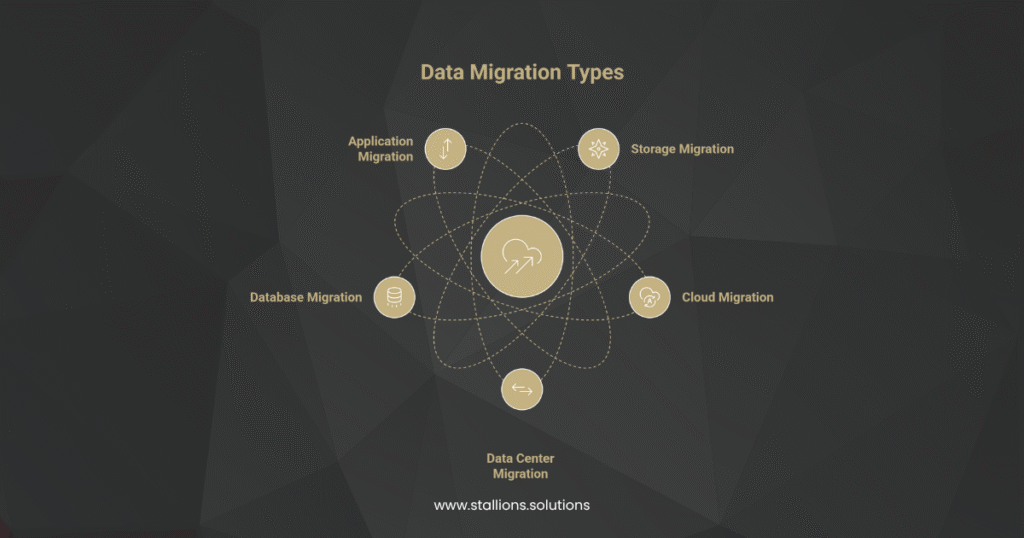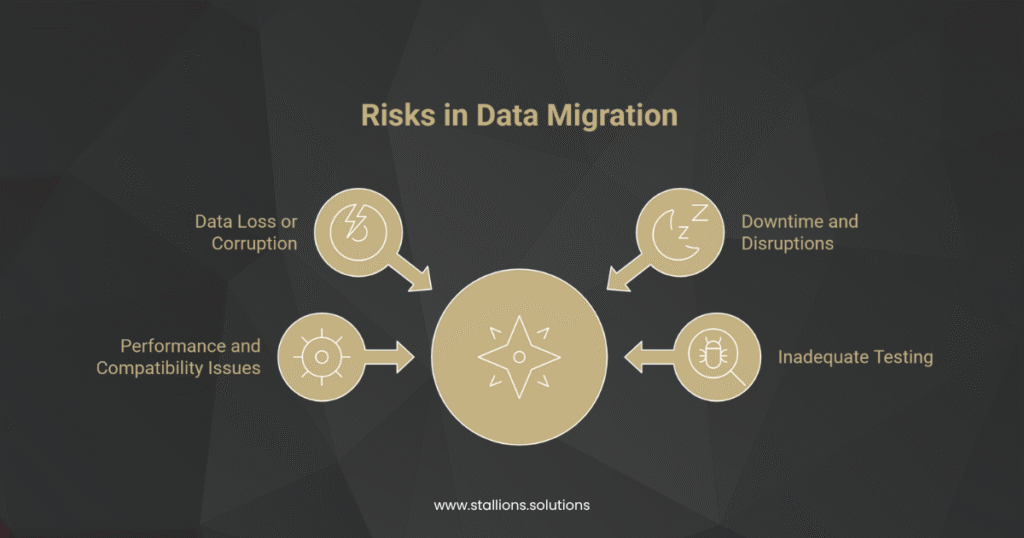Modern businesses thrive on speed and smart decisions, but outdated data systems often hold them back. Old, monolithic platforms were fine for smaller data needs, yet they struggle with today’s reality, huge data volumes, complex formats, and the demand for real-time insights. This creates data silos, slows down processes, and limits scalability, making it harder for companies to stay competitive.
To overcome these challenges, many organizations are turning to data migration. Moving data to modern, flexible platforms, such as cloud or hybrid environments, has become a key strategy for businesses that want to use their data effectively. Data migration not only fixes the problems of legacy systems but also brings big advantages like better scalability, faster performance, and advanced analytics.
In this blog, we’ll explain what data migration is, why it matters, and the different types you should know about, helping your business make the right choice for managing and moving data.
What is Data Migration?
Data migration means moving data from one storage system or computing environment to another. The goal is to improve scalability, boost performance, and meet changing business needs. This process often involves transferring data from old, legacy systems to modern platforms, switching between storage formats or applications, or moving to cloud and hybrid environments. To make this migration smooth and successful, businesses need a clear and well-planned strategy.
As organizations create data faster than ever before, choosing the right place to store and manage it has become critical. Moving to more flexible and efficient systems helps businesses gain better insights, drive innovation, and get the most value from their data.
The Role of a Data Migration Strategy
A successful data migration doesn’t happen by chance, it requires a clear, well-planned strategy. A data migration strategy acts as a roadmap, guiding businesses through every step of the process. It helps evaluate data quality, choose the right migration tools, and set clear objectives. It also identifies potential risks and ensures data moves securely and smoothly, minimizing disruptions.
With a solid plan in place, organizations can confidently select the best environment for their data, whether cloud-based or hybrid. A well-structured strategy not only supports the transition to high-capacity, optimized storage but also enables businesses to unlock the full potential of their data for long-term success.
When Should Your Business Consider Data Migration?
Knowing the right time to migrate data is crucial for keeping your business efficient and adaptable. Certain situations make it necessary to move and reorganize data, so it meets your company’s changing needs. Understanding these scenarios can help you make smart decisions that support growth and innovation. Here are some common reasons to consider data migration:
- Combining multiple data systems into one for easier management
- Moving to cloud or hybrid platforms for better scalability
- Expanding storage capacity to handle growing data needs
- Using advanced tools and applications that require modern systems
- Improving data accessibility and analytics for better insights
- Meeting new compliance or regulatory requirements
- Archiving older, less-used data from legacy systems
- Repurposing data for new business functions
- Transferring data ownership during mergers or restructuring
Understanding Types of Data Migration: Which Approach Fits Your Needs?

Planning a data migration isn’t just about technical steps, it’s about choosing the right approach for your business goals. Different migration types serve different purposes, whether you’re upgrading storage, improving databases, modernizing applications, or moving to the cloud. Selecting the right method ensures data stays secure, accessible, and ready to support growth.
Let’s break down the main types of data migration and how each can help transform your data management strategy.
1. Storage Migration
Storage migration means moving data from one storage system to another. Businesses often do this to replace outdated systems with modern solutions that offer better speed, more capacity, and cost efficiency. While the data format stays the same, this migration improves performance, simplifies backups, and ensures data reliability.
2. Cloud Migration
Cloud migration is one of the most popular options today. It involves moving data or applications to a cloud environment, public, private, or hybrid to gain benefits like scalability, cost savings, and easy access.
There are two main methods:
- Online migration: Data is transferred over the internet or a private network for a real-time move.
- Offline migration: Data is copied to a storage device and physically shipped to the cloud provider, ideal for large volumes.
3. Data Center Migration
This type involves moving an entire data center to a new location or consolidating multiple centers. It can include relocating hardware or migrating workloads. Common reasons include cost reduction, better infrastructure, or business expansion.
Key steps for success:
- Create a detailed migration plan
- Back up all data and test recovery processes
- Ensure compatibility with existing applications
- Assess risks and prepare contingency plans
4. Database Migration

Database migration means transferring data from one database to another, often with the help of specialized tools. Once complete, users access the new database, and the old one is retired. This process is common when upgrading systems or switching to more advanced database platforms.
5. Application Migration
Application migration is the process of moving an application and its related data from one environment to another such as from on-premises infrastructure to the cloud or between cloud providers. This type of migration can be complex because applications often depend on other systems and integrations. Challenges usually arise due to differences in data formats and models between the source and target environments.
When migrating applications to the cloud, adjustments are often needed to ensure the application works properly in its new environment. This includes updating databases, integrations, and workflows so everything runs smoothly.
Before starting, consider these key factors to understand the value and impact of migrating your application:
- Business impact
- Ability to meet core business needs
- Relevance and timeliness of data
- Scale, complexity, and ease of management
- Maintenance and development costs
- Added value from cloud migration
Data Migration Risks: What Should Your Business Watch Out For?

While data migration offers big advantages, it’s not without challenges. Moving critical applications and data especially beyond traditional setups comes with risks that can impact security, compatibility, and overall business operations. Choosing the right tools and services is important, but it’s only part of the equation. Businesses need to be aware of potential pitfalls to ensure a smooth, secure migration.
1. Data Loss or Corruption
One of the biggest risks during migration is losing or corrupting data. When transferring large volumes, data can slip through the cracks, get altered, or become unusable. This can disrupt operations, create compliance issues, and lead to costly errors—turning a strategic move into a setback.
2. Downtime and Disruptions
Migration isn’t always seamless. Some processes require systems to go offline, which can interrupt workflows and customer service. Poorly managed downtime can stall productivity and cause frustration. Careful planning is key to minimizing these disruptions.
3. Performance and Compatibility Issues
Moving data from legacy systems to modern platforms often means dealing with different formats and structures. If not handled properly, this can lead to compatibility problems and slow system performance, reducing the benefits of migration.
4. Inadequate Testing
Skipping thorough testing is a recipe for trouble. Hidden errors often surface after going live, causing data quality issues and operational headaches. Proper testing ensures a smooth transition and avoids costly rework.
How to Get Started with the Data Migration Process
Starting a data migration project can feel overwhelming, but breaking it into simple steps makes the process manageable. Here’s a quick roadmap to guide you:
Assess Your Current Infrastructure
Review your existing systems and data to understand what needs to be moved and identify any challenges.
Define Migration Goals and Needs
Clearly outline what you want to achieve better performance, scalability, compliance, or all of the above.
Plan the Migration Process
Create a detailed plan with timelines, data mapping, and risk mitigation strategies to ensure a smooth transition.
Choose the Right Tools or Partners
Select technologies or service providers that align with your goals to make the migration secure and efficient.
Make Data Migration Simple with Stallions Solutions
When it comes to expert data migration services, Stallions Solutions is your trusted partner. Our experienced team specializes in handling even the most complex migrations whether you’re moving databases, transitioning to high-performance cloud environments, or optimizing existing storage solutions.
We understand that every business has unique needs, which is why we take a tailored approach to every project. From building a comprehensive migration strategy to executing a seamless transition, we focus on minimizing disruptions while ensuring the highest standards of data integrity and security.
Our goal is simple: make your data migration process smooth, efficient, and risk-free, so your organization can fully leverage its data for innovation and growth.
Ready to make your migration a success? Contact us at support@stallions.solutions and let’s get started.



